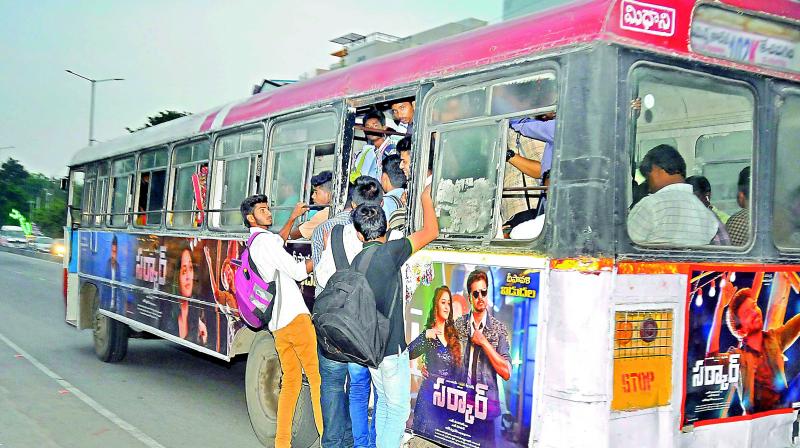Hyderabad: Crowded buses common sight despite accidents

Hyderabad: Overcrowding in state-run Road Transport Corporation (RTC) buses and privately run buses continues despite the major accident at the Kondagattu ghat that claimed 63 lives last month. The Road Transport Corporation and the Road Transport Authority (RTA) are blaming each other for not controlling the problem. While the RTC does not provide sufficient number of buses in areas where demand is high, and the RTA has failed to regularly inspect overcrowding in buses, the issue continues to haunt passengers.
This correspondent has observed that many buses at the Secunderabad railway station do not move on after all the seats are taken and wait for standing space to be filled to overflowing. Moreover, the conductor stops the bus for more people to board along the way. Riding on the footboard is also allowed during peak college and office hours.
In case of an accident, standing passengers will be the worst affected. There have even been instances of passengers dying from suffocation in overcrowded buses.
The usual passenger capacity is around 50 to 60, but is being extended to 115 to 120.
“Overcrowding is not only dangerous at the time of crashes, but it also affects the technical aspects of the bus, like braking, steering and gear function. It worsens the condition of our ageing buses,” says road safety expert Vinod Kumar Kanumala, chief functionary of the Indian Federation of Road Safety.
According to Mr Kanumala, it is the responsibility of the RTA to check violations by vehicles, and the RTC is not ensuring that the RTA does its work.
Public transport usually runs at a loss in most countries the world over because the purpose is to serve the public and not to make profits. This does not mean that the RTC can compromise on safety.
Transport department officers say that lack of staff is one of the reasons they don't conduct checks. C. Ramesh, Joint Transport Commissioner, says: “Due to the lack of staff, our existing inspectors are getting burdened with office work, which is affecting their checking.”
According to the Transport department, 151 cases have been booked against bus drivers whose buses were overcrowded between April and September this year, for which the RTA has not received the amount.
Highly placed sources in the transport department allege that their department is under pressure not to book RTC buses because of the poor financial condition of the corporation. Moreover, the fine for overcrowding is just '100. As such, the emphasis is more on tax evasion violations, in order to meet revenue targets, as these run into lakhs of rupees in fines. In other words, making money is more important than the safety and lives of passengers.
Drivers and conductors say they are the scapegoats, as they are forced to meet targets. N. Krishna, a driver of the Hakimpet depot, and president of the Telangana Jathiya Mazdoor Union (TJMU) explains, “overcrowding is a problem for the staff as well because the conductor won't be able to collect money for tickets from all passengers and check bus passes too. But, we cannot deny service to people when there is no other alternative for them as happens mostly in villages.”
Drivers and conductors also have to meet targets like occupancy ratio and kilometre/per litre targets, else they are subjected to counselling and the humiliating sight of their names displayed on target boards outside the depots.
The RTC administration has a different take on the subject. Executive director M Ravinder says, "The problem of overcrowding occurs only at peak hours in the mornings and evenings for a couple of hours. If we take maximum capacity of people as an average in an area, and run buses accordingly, then it would be a loss to the organisation because then buses will have to ply vacant. We do run extra services during festivals, temple fests, exams, etc."

